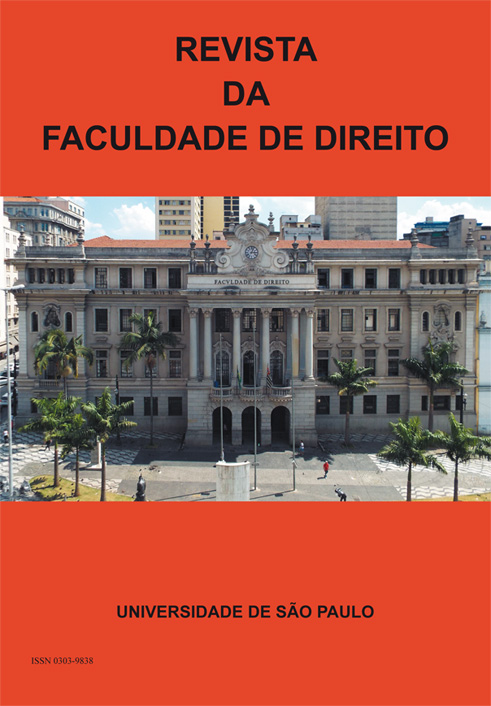Human-machine interaction: the “significant human control” standard and its impacts on the civil liability imputation for damages arising from autonomous vehicles
DOI:
https://doi.org/10.11606/issn.2318-8235.v117p357-376Keywords:
Artificial intelligence, Human-machine interaction, Damages, Torts.Abstract
This paper analyzes the results that advanced digital technologies cause to torts, notably aiming to outline the main legal challenges that such technologies represent for the legal-dogmatic categories related to it. Through the investigation of the diversity of roles of agents involved in the development and use of artificial intelligence, this paper discusses transparency, the unpredictability of the artificial intelligence system actions, and causal link. Furthermore, the research also aimed to investigate the potential of human-machine interaction in the decision-making process and how such dynamics can be relevant to investigation of liability for damages, emphasizing legal gaps and some approaches to solving them. Finally, it investigates how the “meaningful human control” criterion can help prevent damage resulting from autonomous artificial intelligence systems. It also evaluates conceptual distinctions that can facilitate dogmatic development involving artificial intelligence and Brazilian civil liability statutes. The theoretical research, conducted by dialectical and deductive methods, established associations between technology, innovation, and responsibility.
Downloads
References
AMARAL, Francisco. Código civil e interpretação jurídica. Revista Brasileira de Direito Comparado, Rio de Janeiro, n. 44/45, p. 147-167, jan./jun. 2013.
BECK, Ulrich. Sociedade de risco: rumo a uma outra modernidade. Tradução de Sebastião Nascimento. 2. ed. São Paulo: Editora 34, 2011.
BECKERS, Anna; TEUBNER, Gunther. Three liability regimes of artificial intelligence: algorithms actants, hybrids, crowds. Oxford: Hart Publishing, 2022.
BELLET, Thierry; CUNNEEN, Martin; MULLINS, Martin; MURPHY, Finbarr; PÜTZ, Fabian; SPICKERMANN, Florian; BRAENDLE, Claudia; BAUMANN, Martina Felicitas. From semi to fully autonomous vehicles: new emerging risks and ethico-legal challenges for human-machine interactions. Transportation Research Part F: Traffic Psychology and Behaviour, [s. l.], v. 63, p. 153-164, May 2019. Disponível em: https://reader.elsevier.com/reader/sd/pii/S1369847818308556?token=800F16988DEB5CC6A75C6DF866F32F18DCF69D32C839939B58B6E9D709D041F089138A597FCB9B5E39F23166708E74BA&originRegion=us-east-1&originCreation=20220913203026.
FONSECA, Aline Klayse dos Santos. Delineamentos jurídico-dogmáticos da inteligência artificial e seus impactos no instituto da responsabilidade civil. Civilistica.com: Revista Eletrônica de Direito Civil, Rio de Janeiro, v. 10, n. 2, p. 1-36, set. 2021. Disponível em: https://civilistica.emnuvens.com.br/redc/article/download/671/546.
INTERNATIONAL COMMITTEE OF THE RED CROSS. Artificial intelligence and machine learning in armed conflict: a human-centred approach. Geneve, 6 Jun. 2019. Disponível em: https://www.icrc.org/en/document/artificial-intelligence-and-machine-learning-armed-conflict-human-centred-approach. Acesso em: 7 nov. 2022.
KOWERT, Weston. The foreseeability of human-artificial intelligence interactions. Texas Law Review, Austin, v. 96, n, 1, p. 181-204, 2020. Disponível em: https://texaslawreview.org/foreseeability-human-artificial-intelligence-interactions/.
KWIK, Jonathan. A practicable operationalisation of meaningful human control. Laws, Basel, v. 11, n. 3, 21 p., 2022. Disponível em: https://www.mdpi.com/2075-471X/11/3/43/pdf?version=1652699783.
MATTHIAS, Andreas. From coder to creator: responsibility issues in intelligent artifact design. In: LUPPICINI, Rocci; ADELL, Rebecca. Handbook of research on technoethics. New York: IGI Global, 2009. p. 635-650.
MEDON, Filipe. Inteligência artificial e responsabilidade civil: autonomia, riscos e solidariedade. 2. ed. Salvador: JusPodivm, 2022.
NOORMAN, Merel. Computing and moral responsibility. In: ZALTA, Edward Nouri (ed.). The Stanford Encyclopedia of Philosophy, Stanford, 2018. Disponível em: https://plato.stanford.edu/entries/computing-responsibility/.
PAIS-VIEIRA, Miguel; PAIS-VIEIRA, Carla. Interfaces cérebro-máquina e os limites da responsabilidade. In: CURADO, Manuel; FERREIRA, Ana Elisabete; PEREIRA, André Dias (coord.). Vanguardas da responsabilidade: direito, neurociências e inteligência artificial. Coimbra: Petrony, 2019.
PEREIRA, Caio Mário da Silva. Responsabilidade civil. 12. ed., rev., atual. e ampl. Rio de Janeiro: Forense, 2018.
RUSSELL, Stuart; NORVIG, Peter. Inteligência artificial. Tradução: Regina Célia Simille de Macedo. 3. ed. Rio de Janeiro: Elsevier, 2013.
SANTAELLA, Lucia; CARDOSO, Tarcísio. O desconcertante conceito de mediação técnica em Bruno Latour. Matrizes, São Paulo, v. 9, n. 1, p. 167-185, jan./jun. 2015. Disponível em: https://www.revistas.usp.br/matrizes/article/view/100679/99413.
SANTONI DE SIO, Filippo; MECACCI, Giulio. Four responsibility gaps with artificial intelligence: why they matter and how to address them. Philosophy & Technology, [s. l.], v. 34, n. 4, p. 1.057-1.084, May 2021. Disponível em: https://link.springer.com/article/10.1007/s13347-021-00450-x.
SCHELLEKENS, Maurice. Human-machine interaction in self-driving vehicles: a perspective on product liability. International Journal of Law and Information Technology, Oxford, May 2022. Disponível em: https://academic.oup.com/ijlit/advance-article-pdf/doi/10.1093/ijlit/eaac010/43760800/eaac010.pdf. Acesso em: 9 set. 2022.
SIEBERT, Luciano Cavalcante; LUPETTI, Maria Luce; AIZENBERG, Evgeni; BECKERS, Niek; ZGONNIKOV, Arkady; VELUWENKAMP, Herman; ABBINK, David; GIACCARDI, Elisa; HOUBEN, Geert-Jan; JONKER, Catholijn Maria; HOVEN, Jeroen van den; FORSTER, Deborah; LAGENDIJK, Reginald L. Meaningful human control: actionable properties for AI system development. AI Ethics, April 2022. Disponível em: https://link.springer.com/content/pdf/10.1007/s43681-022-00167-3.pdf.
SIMMLER, Monika; FRISCHKNECHT, Ruth. A taxonomy of human-machine collaboration: capturing automation and technical autonomy. AI & Society, New York, v. 36, n. 1, p. 239-250, Mar. 2021. Disponível em: https://doi.org/10.1007/s00146-020-01004-z.
TEPEDINO, Gustavo; SILVA, Rodrigo da Guia. Inteligência artificial e elementos da responsabilidade civil. In: FRAZÃO, Ana; MULHOLLAND, Caitlin (coord.). Inteligência artificial e direito: ética, regulação e responsabilidade. São Paulo: Thomson Reuters Brasil, 2019.
UNIÃO EUROPEIA. Comissão Europeia. Grupo independente de peritos de alto nível sobre Inteligência Artificial. Orientações éticas para uma IA de confiança. Bruxelas, 8 abr. 2019. Disponível em: https://op.europa.eu/en/publication-detail/-/publication/d3988569-0434-11ea-8c1f-01aa75ed71a1/language-pt/format-PDF. Acesso em: 15 set. 2022.
VINEY, Geneviève; JOURDAIN, Patrice; CARVAL, Suzanne. Les conditions de la responsabilité. Paris: LGDJ, 2013. (Collection Traités).
WOJTCZAK, Sylwia; KSIĘŻAK, Paweł. Causation in civil law and the problems of transparency in AI. European Review of Private Law, Dordrecht, v. 29, n. 4, p. 561-582, 2021.
Downloads
Published
Issue
Section
License
Copyright (c) 2023 Revista da Faculdade de Direito, Universidade de São Paulo

This work is licensed under a Creative Commons Attribution-NonCommercial-ShareAlike 4.0 International License.


